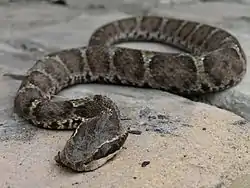< Reconstruction:Proto-Sino-Tibetan < s-b

Reconstruction:Proto-Sino-Tibetan/s-b/m-ruːl
Proto-Sino-Tibetan
Etymology
- Proto-Sino-Tibetan: ?
- Proto-Tibeto-Burman: *s-b/m-ruːl (Matisoff, STEDT); *b-ruːl (Benedict, 1972; Weidert, 1987)

[1] Gloydius blomhoffii.
Descendants
- Old Chinese: 虺 < 虫 /*r̥ujʔ/ (dial. *r̥- > x-) (B-S), /*ŋ̊lulʔ/ (ZS) ("pit viper; snake-brood")
- Himalayish
- Tibeto-Kanauri
- Bodic
- Tibetan
- Written Tibetan: སྦྲུལ (sbrul, “snake, serpent”)
- Tibetan
- Bodic
- Tibeto-Kanauri
- Tangut-Qiang
- Northern Tangut
- Tangut: 𗀋 (phio, /*pʰʲɔ³⁵/, “snake”)
- Northern Tangut
- Lolo-Burmese-Naxi
- Lolo-Burmese: *m-r-wəy¹ (Matisoff, 2003)
- Burmish
- Written Burmese: မြွေ (mrwe, “snake”)
- Burmish
- Lolo-Burmese: *m-r-wəy¹ (Matisoff, 2003)
See also
- *bəw (“insect, bug, vermin; snake”)
- Chinese: 蛇 < 它 (OC /*Cə.laj/, "snake") – etymology uncertain. Likely arose as a taboo word, from the sense "to crawl, to wind". Confer Proto-Austronesian *Sulaʀ (“snake”).
This article is issued from Wiktionary. The text is licensed under Creative Commons - Attribution - Sharealike. Additional terms may apply for the media files.
